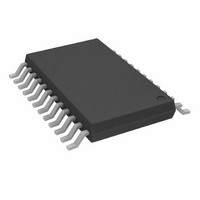AD7730LBRU Analog Devices Inc, AD7730LBRU Datasheet - Page 20

AD7730LBRU
Manufacturer Part Number
AD7730LBRU
Description
IC ADC TRANSDUCER BRIDGE 24TSSOP
Manufacturer
Analog Devices Inc
Datasheet
1.AD7730LBRUZ.pdf
(52 pages)
Specifications of AD7730LBRU
Rohs Status
RoHS non-compliant
Number Of Bits
24
Sampling Rate (per Second)
600
Data Interface
DSP, Serial, SPI™
Number Of Converters
1
Power Dissipation (max)
125mW
Voltage Supply Source
Analog and Digital
Operating Temperature
-40°C ~ 85°C
Mounting Type
Surface Mount
Package / Case
24-TSSOP (0.173", 4.40mm Width)
For Use With
EVAL-AD7730LEBZ - BOARD EVALUATION FOR AD7730EVAL-AD7730EBZ - BOARD EVAL FOR AD7730
Available stocks
Company
Part Number
Manufacturer
Quantity
Price
Company:
Part Number:
AD7730LBRUZ
Manufacturer:
ADI
Quantity:
1 000
Company:
Part Number:
AD7730LBRUZ-REEL7
Manufacturer:
ADI
Quantity:
1 000
AD7730/AD7730L
DAC Register (RS2–RS0 = 1, 0, 0); Power On/Reset Status: 20 Hex
The DAC Register is an 8-bit register from which data can either be read or to which data can be written. This register provides
the code for the offset-compensation DAC on the part. Table XVI outlines the bit designations for the DAC Register. DR0
through DR7 indicate the bit location, DR denoting the bits are in the DAC Register. DR7 denotes the first bit of the data
stream. The number in brackets indicates the power-on/reset default status of that bit. Figure 5 shows a flowchart for reading
from the registers on the AD7730 and Figure 6 shows a flowchart for writing to the registers on the part.
Bit
Location
DR7–DR6
DR5–DR0
Offset Calibration Register (RS2–RS0 = 1, 0, 1); Power-On/Reset Status: 800000 Hex
The AD7730 contains three 24-bit Offset Calibration Registers, labelled Offset Calibration Register 0 to Offset Calibration Reg-
ister 2, to which data can be written and from which data can be read. The three registers are totally independent of each other.
The Offset Calibration Register is used in conjunction with the associated Gain Calibration Register to form a register pair. The
calibration register pair used to scale the output is as outlined in Table XIII. The Offset Calibration Register is updated after an
offset calibration routine (1, 0, 0 or 1, 1, 0 loaded to the MD2, MD1, MD0 bits of the Mode Register). During subsequent
conversions, the contents of this register are subtracted from the filter output prior to gain scaling being performed on the word.
Figure 5 shows a flowchart for reading from the registers on the AD7730 and Figure 6 shows a flowchart for writing to the regis-
ters on the part.
Gain Calibration Register (RS2–RS0 = 1, 1, 0); Power-On/Reset Status: 593CEA
The AD7730 contains three 24-bit Gain Calibration Registers, labelled Gain Calibration Register 0 to Gain Calibration Register
2, to which data can be written and from which data can be read. The three registers are totally independent of each other. The
Gain Calibration Register is used in conjunction with the associated Offset Calibration Register to form a register pair. The
calibration register pair used to scale the output is as outlined in Table XIII. The Gain Calibration Register is updated after a
gain calibration routine (1, 0, 1 or 1, 1, 1 loaded to the MD2, MD1, MD0 bits of the Mode Register). During subsequent con-
versions, the contents of this register are used to scale the number which has already been offset corrected with the Offset Cali-
bration Register contents. Figure 5 shows a flowchart for reading from the registers on the AD7730 and Figure 6 shows a
flowchart for writing to the registers on the part.
Test Register (RS2–RS0 = 1, 1, 1); Power-On/Reset Status: 000000Hex
The AD7730 contains a 24-bit Test Register to which data can be written and from which data can be read. The contents of this
Test Register are used in testing the device. The user is advised not to change the status of any of the bits in this register from the
default (Power-On or RESET) status of all 0s as the part will be placed in one of its test modes and will not operate correctly. If the
part enters one of its test modes, exercising RESET or writing 32 successive 1s to the part will exit the AD7730 from the mode and
return all register contents to their power-on/reset status. Note, if the part is placed in one of its test modes, it may not be possible to
read back the contents of the Test Register depending on the test mode in which the part has been placed.
ZERO (0)
DR7
Bit
Mnemonic
ZERO
DAC5–DAC0 DAC Selection Bits. These bits program the output of the offset DAC. The DAC is effectively
ZERO (0)
DR6
A zero must be written to these bits to ensure correct operation of the AD7730.
6 bits with one sign bit (DAC5) and five magnitude bits. With DAC5 at 1, the DAC output
subtracts from the analog input before it is applied to the PGA. With DAC5 at 0, the DAC
output adds to the analog input before it is applied to the PGA. The DAC output is given by
(V
DAC0. Thus, for a 5 V reference applied across the REF IN pins, the DAC resolution is 2.5 mV
and offsets in the range –77.5 mV to +77.5 mV can be removed from the analog input signal
before it is applied to the PGA. Note, that the HIREF bit has no effect on the DAC range or
resolution, it controls the ADC range only.
Description
REF
/62.5) (D/32) = (V
DAC5 (1)
DR5
Table XVI. DAC Register
DAC4 (0)
DR4
REF
/2000) D where D is the decimal equivalent of bits DAC4 to
–20–
DAC3 (0)
DR3
DAC2 (0)
DR2
DAC1 (0)
DR1
DAC0 (0)
DR0
REV. A













